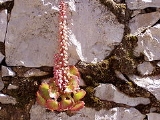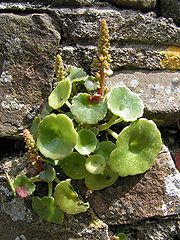
Umbilicus rupestris
Encyclopedia
Umbilicus rupestris is a fleshy, perennial, edible flowering plant
in the stonecrop family Crassulaceae
(in the genus
Umbilicus
) so named for its umbilicate (navel
-like) leaves.
 Wall pennywort grows to an average of 25 cm (10 in) high. The pallid spikes of bell-shaped, greenish-pink flower
Wall pennywort grows to an average of 25 cm (10 in) high. The pallid spikes of bell-shaped, greenish-pink flower
s of this plant first appear in May, and the green fruit
s ripen through the summer.
Both the name "navelwort" and the scientific name "Umbilicus" come from the round shape of the leaves, which have a navel-like depression in the center.
and western Europe
, often growing on shady walls or in damp rock crevices that are sparse in other plant growth (thus, "wall" pennywort), where its succulent leaves develop in rosette
s.
It is not at present under threat.
.
Umbilicus rupestris is "used" in homeopathic medicine. Navelwort is referred to as Cotyledon umbilicus by Homeopaths, since that was the original scientific name of navelwort when Homeopathy
was developed.
Navelwort is also assumed to be the "Kidneywort" referred to by Nicholas Culpepper in the English Physician, although it may actually refer to the unrelated Anemone hepatica
. Culpepper used astrology, rather than science, to classify herbs, and as such is not a reliable source. He claimed: "the juice or the distilled water being drank, is very effectual for all inflammations and unnatural heats, to cool a fainting hot stomach, a hot liver, or the bowels: the herb, juice, or distilled water thereof, outwardly applied, heals pimples, St. Anthony's fire, and other outward heats. The said juice or water helps to heal sore kidneys, torn or fretted by the stone, or exulcerated within; it also provokes urine, is available for the dropsy, and helps to break the stone. Being used as a bath, or made into an ointment, it cools the painful piles or hæmorrhoidal veins. It is no less effectual to give ease to the pains of the gout, the sciatica, and helps the kernels or knots in the neck or throat, called the king's evil: healing kibes and chilblains if they be bathed with the juice, or anointed with ointment made thereof, and some of the skin of the leaf upon them: it is also used in green wounds to stay the blood, and to heal them quickly."
Flowering plant
The flowering plants , also known as Angiospermae or Magnoliophyta, are the most diverse group of land plants. Angiosperms are seed-producing plants like the gymnosperms and can be distinguished from the gymnosperms by a series of synapomorphies...
in the stonecrop family Crassulaceae
Crassulaceae
Crassulaceae, or the orpine family, are a family of dicotyledons. They store water in their succulent leaves. They are found worldwide, but mostly occur in the Northern Hemisphere and southern Africa, typically in dry and/or cold areas where water may be scarce...
(in the genus
Genus
In biology, a genus is a low-level taxonomic rank used in the biological classification of living and fossil organisms, which is an example of definition by genus and differentia...
Umbilicus
Umbilicus (genus)
Umbilicus is a genus of over ninety species of flowering plants in the family Crassulaceae. Many of its species have been given synonyms under different genera such as Rosularia, Cotyledon, and Chiastophyllum...
) so named for its umbilicate (navel
Navel
The navel is a scar on the abdomen caused when the umbilical cord is removed from a newborn baby...
-like) leaves.

Flower
A flower, sometimes known as a bloom or blossom, is the reproductive structure found in flowering plants . The biological function of a flower is to effect reproduction, usually by providing a mechanism for the union of sperm with eggs...
s of this plant first appear in May, and the green fruit
Fruit
In broad terms, a fruit is a structure of a plant that contains its seeds.The term has different meanings dependent on context. In non-technical usage, such as food preparation, fruit normally means the fleshy seed-associated structures of certain plants that are sweet and edible in the raw state,...
s ripen through the summer.
Both the name "navelwort" and the scientific name "Umbilicus" come from the round shape of the leaves, which have a navel-like depression in the center.
Distribution
The plant is found in southernSouthern Europe
The term Southern Europe, at its most general definition, is used to mean "all countries in the south of Europe". However, the concept, at different times, has had different meanings, providing additional political, linguistic and cultural context to the definition in addition to the typical...
and western Europe
Western Europe
Western Europe is a loose term for the collection of countries in the western most region of the European continents, though this definition is context-dependent and carries cultural and political connotations. One definition describes Western Europe as a geographic entity—the region lying in the...
, often growing on shady walls or in damp rock crevices that are sparse in other plant growth (thus, "wall" pennywort), where its succulent leaves develop in rosette
Rosette (botany)
In botany, a rosette is a circular arrangement of leaves, with all the leaves at a single height.Though rosettes usually sit near the soil, their structure is an example of a modified stem.-Function:...
s.
It is not at present under threat.
Medicinal Usage
Umbilicus rupestris is not the same "Pennywort" as the one used in Asian medicine, which is the unrelated Asiatic Pennywort, Centella asiaticaCentella asiatica
Centella asiatica is a small herbaceous annual plant of the family Mackinlayaceae or subfamily Mackinlayoideae of family Apiaceae, and is native to India, Sri Lanka, northern Australia, Indonesia, Iran, Malaysia, Melanesia, Papua New Guinea, and other parts of Asia...
.
Umbilicus rupestris is "used" in homeopathic medicine. Navelwort is referred to as Cotyledon umbilicus by Homeopaths, since that was the original scientific name of navelwort when Homeopathy
Homeopathy
Homeopathy is a form of alternative medicine in which practitioners claim to treat patients using highly diluted preparations that are believed to cause healthy people to exhibit symptoms that are similar to those exhibited by the patient...
was developed.
Navelwort is also assumed to be the "Kidneywort" referred to by Nicholas Culpepper in the English Physician, although it may actually refer to the unrelated Anemone hepatica
Anemone hepatica
Anemone hepatica is a herbaceous perennial growing from a rhizome in the buttercup family , native to woodland in temperate regions of the Northern Hemisphere.- Taxonomy :The taxonomy of the genus Anemone and its species is not fully resolved...
. Culpepper used astrology, rather than science, to classify herbs, and as such is not a reliable source. He claimed: "the juice or the distilled water being drank, is very effectual for all inflammations and unnatural heats, to cool a fainting hot stomach, a hot liver, or the bowels: the herb, juice, or distilled water thereof, outwardly applied, heals pimples, St. Anthony's fire, and other outward heats. The said juice or water helps to heal sore kidneys, torn or fretted by the stone, or exulcerated within; it also provokes urine, is available for the dropsy, and helps to break the stone. Being used as a bath, or made into an ointment, it cools the painful piles or hæmorrhoidal veins. It is no less effectual to give ease to the pains of the gout, the sciatica, and helps the kernels or knots in the neck or throat, called the king's evil: healing kibes and chilblains if they be bathed with the juice, or anointed with ointment made thereof, and some of the skin of the leaf upon them: it is also used in green wounds to stay the blood, and to heal them quickly."
Properties
- Vulnerary : The plant is sometimes employed to ease pain on scratches by applying the leaf to the skin after removing the lower cuticlePlant cuticlePlant cuticles are a protective waxy covering produced only by the epidermal cells of leaves, young shoots and all other aerial plant organs without periderm...
.

